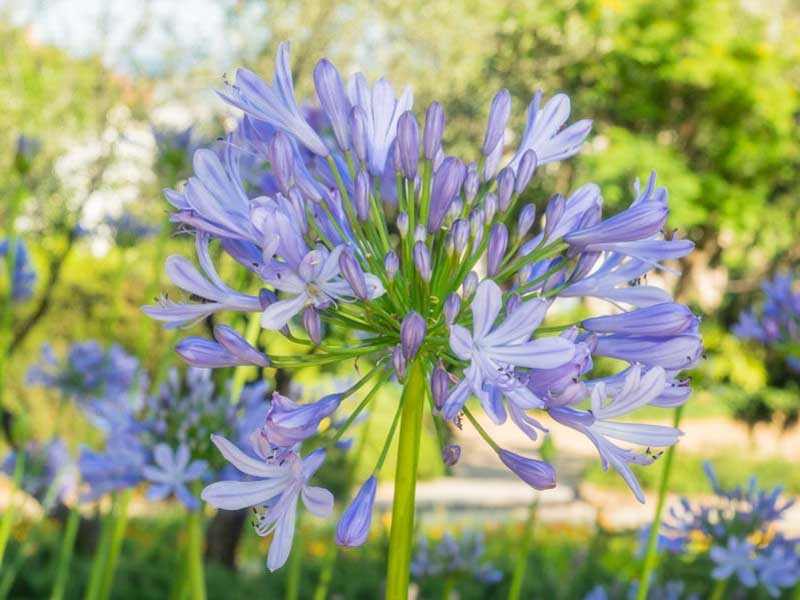Expanding Agapanthus: A Complete Guide to Beautiful Blooms
Expanding Agapanthus: A Complete Guide to Beautiful Blooms
Blog Article
Understanding the Art of Agapanthus Care: Necessary Steps for Healthy Development and Vivid Flowers
In the realm of cultivation, the farming of agapanthus stands as a rewarding venture for those that look for to support these classy blooming plants. With their striking blossoms and stylish vegetation, agapanthus has actually recorded the attention of garden enthusiasts worldwide. Nevertheless, achieving optimal growth and dynamic blossoms needs a nuanced technique that includes different important steps. From selecting the right variety to understanding trimming strategies, the journey towards growing thriving agapanthus plants is diverse and holds the key to unlocking the full potential of these organic gems.

Selecting the Right Agapanthus Selection

When selecting the best Agapanthus selection for your garden, take into consideration elements such as environment suitability, flower color, and development habit. Additionally, take into consideration the environment in your area to make certain the Agapanthus selection you pick can thrive in your particular conditions. Comprehending the growth behavior of different Agapanthus selections is essential for correct positioning within your garden.
Ideal Growing Conditions
Thinking about the optimal ecological requirements is crucial for effective Agapanthus cultivation. Agapanthus thrives in well-draining soil with a somewhat acidic to neutral pH level. When planting, select an area that obtains full sunlight to partial color. In hotter climates, providing some afternoon shade can avoid scorching of the fallen leaves. Agapanthus plants are delicate to cool temperature levels and need to be shielded from frost during cold weather.
To ensure healthy growth and dynamic blossoms, plant Agapanthus bulbs at a depth of concerning 2-4 inches and area them 8-12 inches apart. Mulching around the base of the plants assists keep dampness and reduces weed development.
Watering and Feeding Tips
Keeping appropriate moisture levels and giving essential nutrients are vital components in the treatment regimen for Agapanthus plants. When it comes to sprinkling Agapanthus, it is essential to strike an equilibrium. These plants choose constantly moist soil but are prone to root rot if overwatered.
Fertilizing Agapanthus is essential for advertising healthy and balanced growth and respected blooms. Apply a balanced fertilizer, such as a 10-10-10 formula, in the early spring as new growth arises. By adhering to these watering and fertilizing tips, you can guarantee your Agapanthus plants flourish and produce lively, durable flowers.
Trimming Strategies for Agapanthus
Pruning Agapanthus plants at the appropriate times and with proper methods is important for keeping their health and wellness and promoting optimum growth and flowering. The perfect time to trim Agapanthus remains in late winter or early spring prior to new growth arises. Beginning by getting rid of any dead or yellowing fallen leaves near the base of the plant. Cut them as close to the ground as feasible without damaging the arising shoots.
For flowered stems, wait up until the flowers have actually withered and after that cut them back to the base. This not only cleans up the plant's look however also motivates the development of new blossom buds. Deadheading invested flowers can likewise redirect the plant's power right into generating more blossoms instead than establishing seeds. Nonetheless, if you desire to collect seeds for breeding, leave some flowers to completely dry and mature on the plant.
Remember to use clean, sharp devices to make precise cuts and lower the risk of presenting conditions. Agapanthus. Regular pruning will certainly aid keep your Agapanthus looking cool and healthy and balanced while ensuring a bountiful screen of lovely blossoms
Managing Typical Parasites and Illness
After ensuring proper trimming strategies for Agapanthus, it is crucial to address usual bugs and conditions that can impact the wellness and vitality of these plants. Agapanthus plants are normally sturdy however can still succumb to particular problems. One common insect that impacts Agapanthus is the Agapanthus gall midget. This little, orange fly lays its eggs in the vegetation, causing distorted growth and blossom buds that stop working to open up. To combat this pest, prune and ruin any kind of afflicted plant parts and think about utilizing insecticidal soap.
One more common problem is fungal fallen leave place, which presents as dark lesions on the fallen leaves. To protect against fungal illness, guarantee excellent air blood circulation around the plants, prevent above watering, and eliminate any type of infected fallen leaves without delay. In addition, Agapanthus plants can struggle with root rot if they are grown in badly draining soil. To avoid this, plant Agapanthus in well-draining dirt and stay clear of overwatering. By being watchful and taking prompt activity against conditions and bugs, you can aid your Agapanthus plants prosper and generate lively blooms.
:strip_icc()/purple-agapanthus-4637b426-ba6babc24ea34dce9361ec746f6ebc63.jpg)
Final Thought
In verdict, understanding the art of agapanthus care involves choosing the have a peek here right variety, providing optimal growing conditions, proper watering and feeding, appropriate trimming strategies, and resolving typical bugs and conditions. By following these important steps, you can make sure healthy and balanced growth and lively blossoms for your agapanthus plants. Bear in mind to frequently keep an eye on and maintain your plants to advertise their total well-being and longevity.
To ensure healthy and balanced development and lively flowers, plant Agapanthus bulbs at a deepness of regarding 2-4 inches and space them 8-12 inches apart. By complying with these watering and feeding tips, you can ensure your Agapanthus plants thrive and create vivid, resilient blooms.
One usual parasite that impacts Agapanthus is the Agapanthus gall midge. Furthermore, read here Agapanthus plants YOURURL.com can suffer from origin rot if they are planted in improperly draining pipes dirt. By following these essential steps, you can make sure healthy development and vibrant blooms for your agapanthus plants.
Report this page